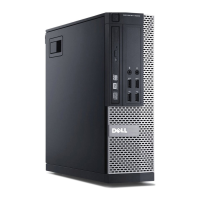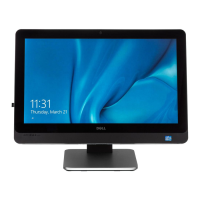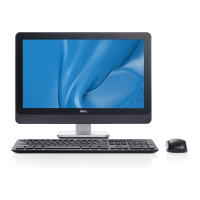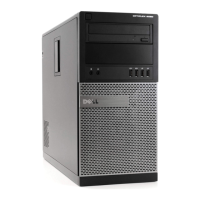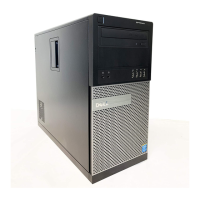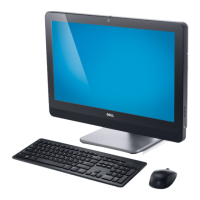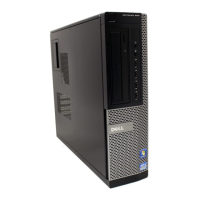Do you have a question about the Dell OptiPlex 9030 and is the answer not in the manual?
Safety guidelines and pre-operation checks before working inside the computer.
Step-by-step instructions for safely shutting down the computer.
Procedures to follow after completing internal component work before powering on.
Guide for removing and reinstalling the central processing unit (CPU).
Procedures for removing and reinstalling the main computer circuit board.
Covers system info, network, SATA, drives, USB, audio, OSD, and misc devices.
Manages passwords, TPM, CPU features, and chassis intrusion.
Manages virtualization, wireless, cloud desktop, and BIOS updates.
Instructions for assigning, changing, or deleting system and setup passwords.
| Tcase | 71.35 °C |
|---|---|
| Bus type | DMI |
| Stepping | C0 |
| Tjunction | - °C |
| FSB Parity | No |
| Processor code | SR1QN |
| Processor cache | 6 MB |
| Processor cores | 4 |
| Processor model | i5-4590S |
| System bus rate | 5 GT/s |
| 64-bit computing | Yes |
| Processor family | Intel® Core™ i5 |
| Processor series | Intel Core i5-4500 Desktop Series |
| Processor socket | LGA 1150 (Socket H3) |
| Processor codename | Haswell |
| Number of QPI links | 0 |
| Processor frequency | 3 GHz |
| Processor cache type | Smart Cache |
| Configurable TDP-down | - W |
| Processor lithography | 22 nm |
| Processor manufacturer | Intel |
| Processor front side bus | - MHz |
| PCI Express slots version | 3.0 |
| Processor boost frequency | 3.7 GHz |
| Processor operating modes | 64-bit |
| PCI Express configurations | 1x16, 2x8, 1x8+2x4 |
| Thermal Design Power (TDP) | 65 W |
| Maximum number of PCI Express lanes | 16 |
| Memory types supported by processor | DDR3-SDRAM |
| Memory voltage supported by processor | 1.5 V |
| Memory channels supported by processor | Dual |
| Memory clock speeds supported by processor | 1333, 1600 MHz |
| Memory bandwidth supported by processor (max) | 25.6 GB/s |
| Maximum internal memory supported by processor | 32 GB |
| On-board graphics card ID | 0x412 |
| Discrete graphics card model | Not available |
| On-board graphics card model | Intel® HD Graphics 4600 |
| On-board graphics card family | Intel® HD Graphics |
| Maximum on-board graphics card memory | 1.024 GB |
| On-board graphics card OpenGL version | 4.3 |
| On-board graphics card base frequency | 350 MHz |
| On-board graphics card DirectX version | 11.1 |
| On-board graphics card dynamic frequency (max) | 1150 MHz |
| Number of displays supported (on-board graphics) | 3 |
| Scalability | 1S |
| Processor ARK ID | 80816 |
| Intel TSX-NI version | 0.00 |
| Processor package size | 37.5 x 37.5 mm |
| CPU configuration (max) | 1 |
| Supported instruction sets | AVX 2.0, SSE4.1, SSE4.2 |
| Thermal solution specification | PCG 2013C |
| Intel® Smart Response Technology | - |
| Intel Identity Protection Technology version | 1.00 |
| Pixel pitch | 0.2652 x 0.2652 mm |
| Screen shape | Flat |
| Display diagonal | 23 \ |
| Native aspect ratio | 16:9 |
| Intel segment tagging | Enterprise, Small Business |
| Memory slots | 2 |
| Internal memory | 4 GB |
| Memory slots type | SO-DIMM |
| Memory clock speed | 1600 MHz |
| Memory form factor | DIMM/SO-DIMM |
| Internal memory type | DDR3L-SDRAM |
| Maximum internal memory | 16 GB |
| Memory layout (slots x size) | 2 x 4 GB |
| HDD speed | 5400 RPM |
| HDD interface | SATA |
| Storage media | HDD |
| Optical drive type | DVD Super Multi |
| Total storage capacity | 500 GB |
| Compatible memory cards | SD |
| Audio system | Waves MaxxAudio Pro |
| RMS rated power | 7.6 W |
| Wi-Fi standards | 802.11a, 802.11g, Wi-Fi 4 (802.11n) |
| Bluetooth version | 4.0 |
| Ethernet LAN data rates | 10, 100, 1000 Mbit/s |
| USB 2.0 ports quantity | USB 2.0 ports have a data transmission speed of 480 Mbps, and are backwards compatible with USB 1.1 ports. You can connect all kinds of peripheral devices to them. |
| USB 3.2 Gen 1 (3.1 Gen 1) Type-A ports quantity | 6 |
| Operating system installed | Ubuntu Linux |
| Disc types supported | CD, DVD |
| Product color | Black |
| Product type | All-in-One PC |
| Total megapixels | 2 MP |
| AC adapter power | 180 W |
| AC adapter frequency | 50/60 Hz |
| AC adapter input voltage | 100 - 240 V |
| Storage temperature (T-T) | -40 - 65 °C |
| Operating temperature (T-T) | 0 - 35 °C |
| Operating relative humidity (H-H) | 20 - 80 % |
| Sustainability certificates | RoHS, ENERGY STAR |
| Depth (with stand) | 205 mm |
|---|---|
| Width (with stand) | 567.5 mm |
| Height (with stand) | - mm |
| Weight (with stand) | - g |
| Depth (without stand) | 60 mm |
| Height (without stand) | 380.7 mm |
| Weight (without stand) | 14010 g |
